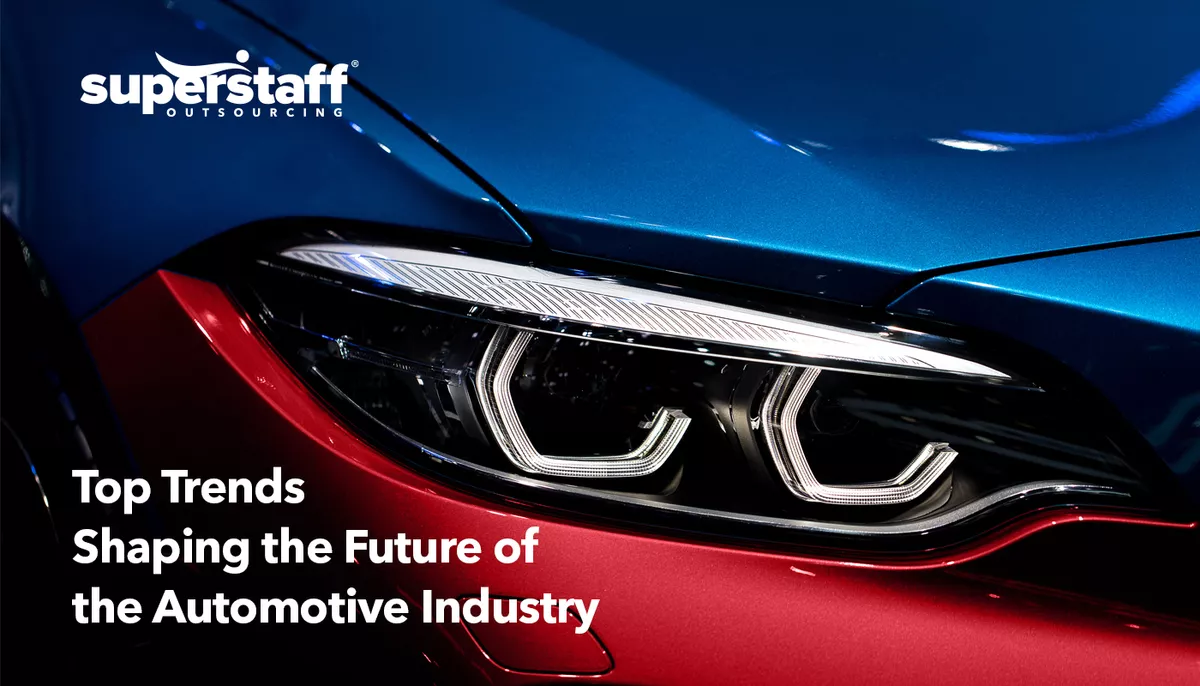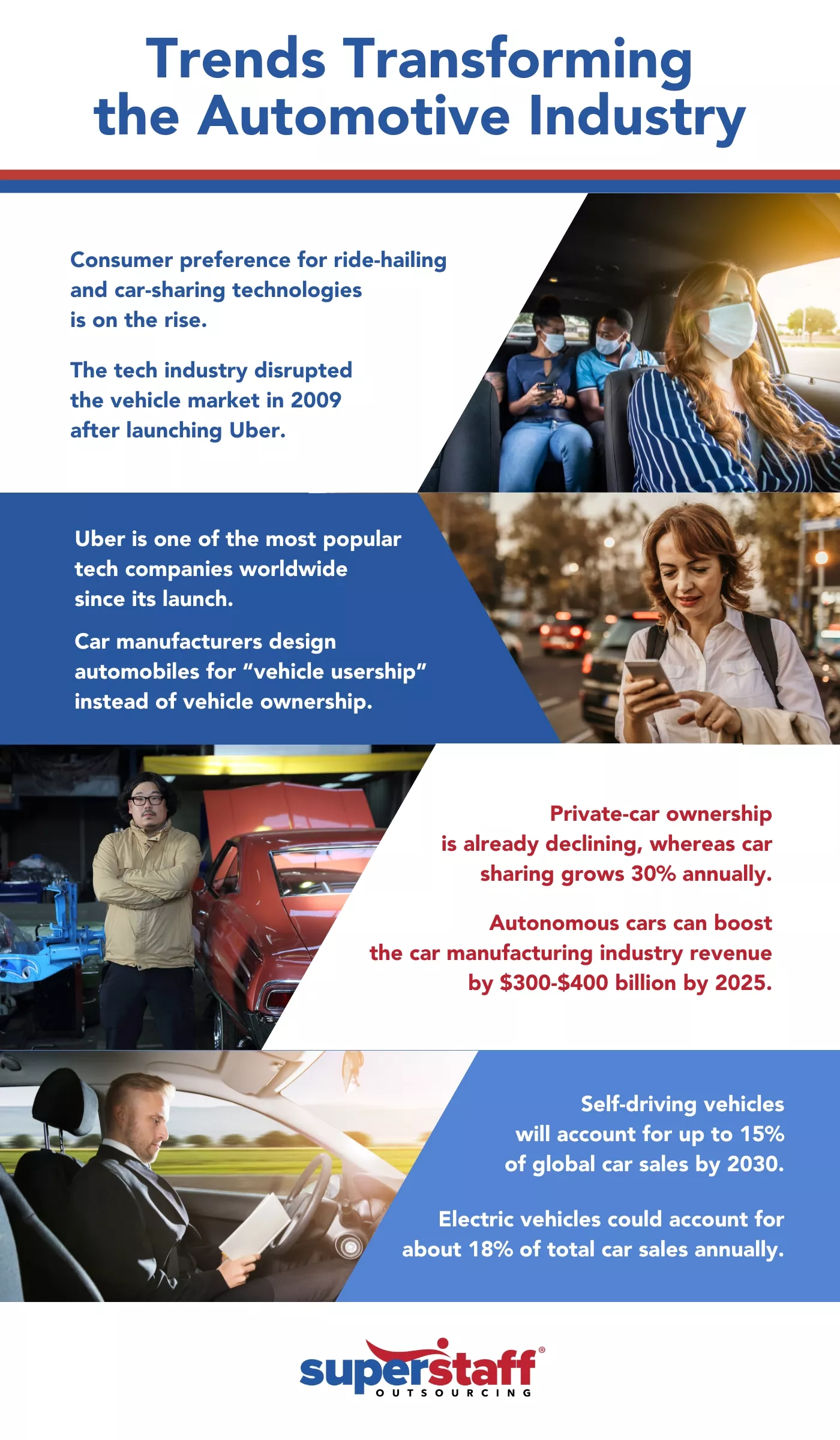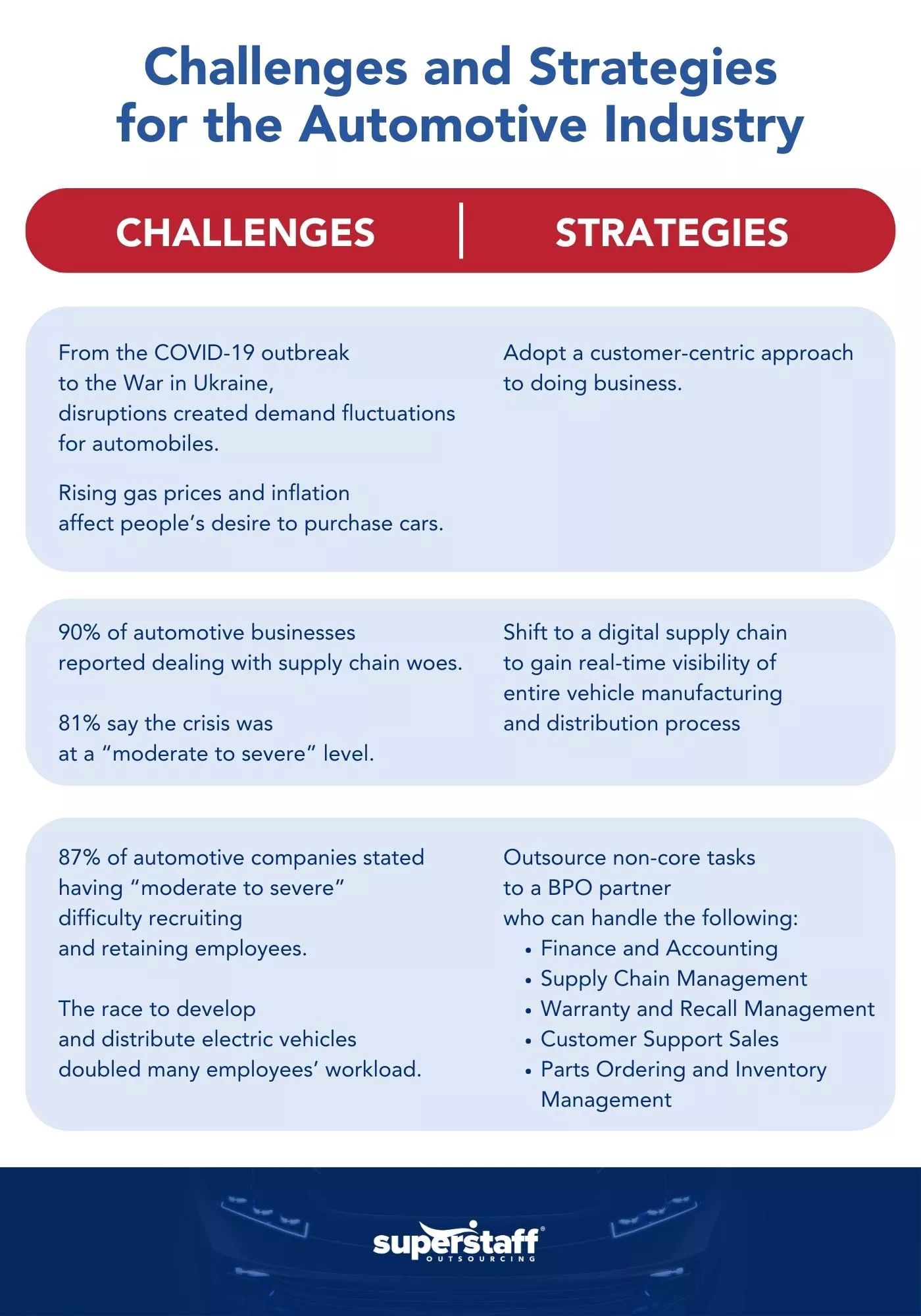
The global vehicle manufacturing industry is undergoing a significant transition. The sector may never be the same in just a few short years, driven by changing consumer behavior, sustainability, technological disruptions, and other emerging trends.
Although the traditional business models of designing, manufacturing, selling, and servicing vehicles remain the same, today’s car companies are racing toward a new world where mobility and connectivity are the deciding factors.
What does the future of the automotive industry look like in 2023 and beyond? This article will examine today’s vehicle manufacturers’ top trends and challenges.
We’ll also discuss the strategies these car companies can use to their advantage.
Emerging Automotive Market Trends and Other Opportunities in the Automotive Industry
➡️What’s My Next Step? Send Us An Email

Shared Mobility
Transportation preferences are continuously evolving. In the past, people had to buy cars or take a chance on public transportation, such as buses, trains, and taxi cabs.
Then, in 2009, the tech industry disrupted the vehicle market by launching Uber. This global ride-hailing app allowed car owners to share a ride and earn a side income while giving commuters more transportation options.
Over a decade since its launch, Uber continues to be one of the most popular and fastest-growing tech companies in the United States and worldwide. And the result of their success highlighted the demand for automotive mobility services.
Transitioning From Vehicle Ownership to “Vehicle Usership”
Car companies will likely still prioritize vehicle sales for individuals, families, and corporations. However, many also recognize the untapped potential of shared mobility as an extra revenue stream. The concept of mobility is user-centric, acknowledging that different people may have other transportation preferences and needs.
As the cost of living and inflation rates soar, today’s consumers are more open to paying for temporary access than buying items outright. For instance, movie enthusiasts used to buy physical media such as CDs, DVDs, and Blu-rays to watch their favorite films. Today’s audiences are shifting toward streaming subscriptions and video-on-demand (VOD) services.
The automobile industry is undergoing a similar consumer preference shift. Instead of focusing only on vehicle ownership, some manufacturers design and optimize their automobiles for “vehicle usership,” utilizing ride-hailing and car-sharing technologies and subscription services.
A recent Deloitte report found that 84% of Americans are concerned about the rising costs of everyday purchases. This explains why many cannot afford big purchases (such as personal vehicles) and instead turn to ride-sharing services.
At the same time, a McKinsey study paralleled the findings of this report, observing that private-car ownership in the U.S. is already declining, while there has been a 30% annual growth in car sharing in North America over the last five years.
Constant Connectivity
Beyond on-demand mobility, connectivity is also among the top trends in the automotive industry today. As new technologies emerge, car manufacturers must keep up with the latest innovations to create efficient, high-tech vehicles that appeal to the modern consumer. And this is where the “connected car” concept comes in.
Connected cars are vehicles that can access the Internet through built-in connectivity systems. Some features include real-time global positioning systems (GPS), traffic prediction, advanced security features, vehicle-to-vehicle communication, and remote operation of certain car functionalities.
According to a McKinsey study, the automotive industry can increase its revenue pools by up to 30% by offering connectivity services and feature upgrades, adding up to $1.5 trillion in extra revenue.
Autonomous Vehicles
Imagine driving between different destinations seamlessly and effortlessly, all without maneuvering your car. Self-driving vehicles have long been a dream for many car enthusiasts, but today’s innovative technologies are slowly making this once-fantastical idea a reality.
An autonomous car relies on sensors, artificial intelligence (AI) and machine learning systems, complex algorithms, and processors to function as intended. Its sensors create a map of its surroundings and detect nearby obstacles and vehicles, which help the car measure distances, follow traffic rules, and quickly navigate streets.
Fully autonomous vehicles are still undergoing further research and testing, and, as of this writing, none are available to the general public. However, industry experts predict that self-driving vehicles will shape the future of automotive transportation.
According to a McKinsey report, autonomous cars could generate between $300 billion to $400 billion in revenue for the car manufacturing industry by as early as 2025. Then, industry experts forecast that these self-driving vehicles will account for up to 15% of global car sales by 2030.
Electric Cars
The shift from traditional gas-fueled cars to the rise of electric vehicles is also among the key future trends in the automobile industry.
According to a 2023 Executive Summary released by the International Energy Agency, experts predict that about 1 out of every five vehicles sold this year will be electric. The same report noted that electric vehicles could account for about 18% of total car sales annually.
Rising gas prices fuel the demand for electric cars due to inflation, geopolitical tensions (such as the War in Ukraine), and supply chain challenges. Today’s car owners are also becoming increasingly concerned about the environment and sustainability, with many advocating less dependence on nonrenewable resources like gasoline and diesel fuel.
Even though more manufacturers, from Tesla to Porsche, are shifting their resources to create electric vehicles, one challenge for future sales is the need for charging infrastructure.
The challenge for many automotive businesses will be to invest in charging stations so that more consumers can be encouraged to buy electric cars.
Top Challenges and Changes in the Automotive Industry
➡️How Do I Start With My Outsourcing? Book A Free Call

Changing Consumer Demands
Over the past few years, consumer demand has never been more difficult for the auto industry to predict. We live in the Age of Constant Disruption, and these recent events–from the COVID-19 outbreak to the War in Ukraine–have created substantial fluctuations in demand for automobiles.
At the height of the pandemic, vehicle sales decreased because of the quarantine and lockdown period. Post-COVID, many employees continue to work from home, driving down the importance of car ownership.
Although car sales are beginning to increase again, the numbers still have not reached pre-pandemic levels. Before COVID-19, vehicle sales averaged about 17.3 million, but sales only reached 14.9 million in 2021.
In addition, rising gas prices and inflation rates affect people’s desire to purchase automobiles. The challenge for automotive companies is knowing how to pivot and adapt to environmental and consumer market changes to chart a path forward for their business.
Supply Chain Challenges
In addition to constantly evolving consumer demand, the automotive sector faces supply chain disruptions. One survey found that 90% of automotive businesses reported dealing with supply chain woes, with 81% saying their crisis was at a “moderate to severe” level.
Because of supply chain bottlenecks, car manufacturers have struggled to access essential raw materials and resources, such as windshield wiper motors and wiring harnesses. One of the most significant hurdles has been the worldwide semiconductor shortage, contributing to over 10 million units of lost vehicle production.
According to industry experts, supply chain challenges are likely to continue throughout the rest of the year. So, auto manufacturers and suppliers are encouraged to diversify their sourcing activities and strengthen their logistics operations to stay afloat.
Automotive Labor Shortages
Like many other industries, the automotive sector is experiencing widespread labor shortages. The labor crunch affects all aspects of vehicle manufacturing, from the factory level to more specialized roles like engineering and technology.
According to a Fisher Phillips survey, 87% of automotive companies stated having “moderate to severe” difficulty recruiting and retaining employees.
One reason for the automotive labor crisis is the greater demand for electric vehicles. In the past, manufacturers focused on gas-based automobiles, but the race to develop and distribute electric vehicles doubled many employees’ workload.
For instance, automobile program managers only took on about 20 programs, but as the demand for electric cars increased, so did their duties. Now, the average program manager handles as many as 40 programs simultaneously.
Critical Strategies for the Automobile Sector in 2023 and Beyond
Adopt a customer-centered approach to business.
In this age of disruption and uncertainty, only one thing remains constant: your customers are the cornerstone of your business. Even as consumer demand shifts and preferences evolve, your automotive company should put customers first.
Adopting a customer-centric approach affects all aspects of your automotive business, starting with designing vehicles that meet buyer needs, all the way to investing in a reliable customer support team that listens to feedback and helps make sure that every consumer has a seamless experience with your brand.
With an outstanding customer service team by your side, you can ensure that buyers can reach out to you no matter the time or day and on whichever platform they choose.
Utilize a digital supply chain and smart manufacturing models.
Instead of relying on legacy models, automotive companies must adapt and incorporate new technologies into their daily operations. By shifting to a digital supply chain, car businesses gain real-time visibility into every step of their vehicle manufacturing and distribution process, allowing for greater transparency and coordination between different stakeholders.
Smart manufacturing systems also automate and streamline many facets of your production process. Innovations can allow manufacturers to run simulations and tests while designing a new vehicle, ensuring the product’s viability without wasting too many resources.
To ensure that your entire supply chain is well-organized, you could also enlist the help of a reliable BPO. The right provider can help you with supply chain management and other crucial back-office solutions.
Work with a BPO that stays on top of future trends in the automobile industry.
Outsourcing can be the ideal solution for automotive businesses hoping to improve their flexibility and resilience amid constant disruptions, fluctuations in consumer demand, changes in market trends, supply chain bottlenecks, and labor shortages.
You can focus on your core competencies through outsourcing while ensuring qualified professionals take care of your crucial back-office tasks.
The right BPO partner can handle a wide range of functions, including:
- Finance and Accounting
- Supply Chain Management
- Warranty and Recall Management
- Customer Support Sales
- Parts Ordering and Inventory Management
Working with a BPO partner also allows you to fortify your business operations while being flexible enough to adapt to changes in the global marketplace.
Prepare for the Future of the Automotive Industry As Early As Today
➡️Curious About SuperStaff’s Most Common Outsourced Roles? Talk To Us
The global vehicle manufacturing sector is still navigating one of its most challenging historical transition periods. However, the good news is that there is a way for you to prepare your company for the future of the automotive industry as early as today: by partnering with a reliable outsourcing provider.
At SuperStaff, we are committed to helping automotive businesses address the present and future challenges facing their industry by connecting them with a top-notch outsourced workforce that can help streamline their operations, improve their productivity, and lighten the load of their core team.
Reach out to us, and learn more about how our outsourcing solutions can empower your growing automotive business!






